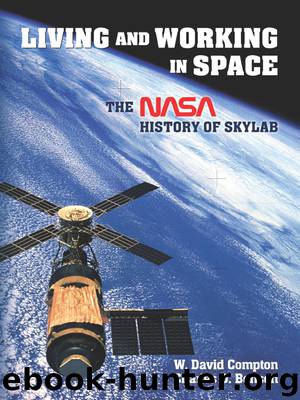Living and Working in Space by Compton William David; Benson Charles D.; Dickson Paul

Author:Compton, William David; Benson, Charles D.; Dickson, Paul
Language: eng
Format: epub
Publisher: Dover Publications
Published: 2013-09-19T04:00:00+00:00
Astronaut Joseph P. Kerwin removing experiment equipment from a storage locker on the top deck of the workshop trainer. During the missions, unpacking and restowing equipment and supplies would take a surprising amount of time. S-72-40260.
During 1970 opportunities for the scientist-astronauts declined further. In January NASA canceled one Apollo flight; in September, two more. It seemed likely that no scientist would explore the moon. Late that year the Space Science Board sought assurances from NASA that two scientists would fly on each Skylab mission. The board’s action coincided with a resurgence of dissatisfaction among the scientist-astronauts in Houston. Homer Newell, NASA’s top-ranking scientist, went to Houston in January 1971 to hear their complaints and see what could be done about them. One by one the scientist-astronauts told Newell that they could not get a fair shake as long as a test pilot (Slayton) picked the crews. As they saw it, his choices were determined by flying time, special skills, and personal relations. Science was not a consideration; in fact, those who showed more interest in science could be at a disadvantage. Several astronauts recommended that Headquarters establish criteria for crew membership, preferably with some appreciation for science. The group felt strongly that each Skylab mission should include two scientists. One of them noted, “flight operations take only a small fraction of the time required for science and other objectives.”18
Newell incorporated much of what was said in his recommendations to the administrator. On the sensitive issue of crew selection, he urged that Harrison Schmitt (the only astronaut with a Ph.D. in geology) be assigned to a lunar landing as early as possible and that two scientists be considered for each Skylab flight. He also proposed a review of NASA’s crew-selection process and suggested restructuring the scientist-astronaut program to allow a greater commitment to a scientific career. Since he had heard only one side of the issue, Newell labeled his recommendations “tentative.”19
The recommendations touched off several months of debate concerning the makeup of Skylab crews. Slayton and Gilruth argued against more than one scientist per flight, reasoning that hardware problems would demand a high level of systems expertise, an area in which test pilots were thought to excel. Gilruth informed Dale Myers in June that reliability studies indicated “a high probability of systems problems … during the mission.” Since the workshop’s systems could not be modified after launch, Houston was directing most of its training to “systems management and malfunction procedures.” He also pointed out that Skylab missions had been planned around a concept of maximum cross-training, which would give each crewman roughly the same degree of proficiency on all major experiments. Consequently, an astronaut’s specific academic background was relatively unimportant.20
Myers wanted to accommodate the scientists by including a second scientist on at least one mission, but Gilruth’s arguments were persuasive, and Myers remained undecided. When three Soviet cosmonauts died on 29 June during reentry, however, he agreed that NASA should give operational considerations top priority. On 6 July Myers recommended approval
Download
This site does not store any files on its server. We only index and link to content provided by other sites. Please contact the content providers to delete copyright contents if any and email us, we'll remove relevant links or contents immediately.
| Automotive | Engineering |
| Transportation |
Whiskies Galore by Ian Buxton(41516)
Introduction to Aircraft Design (Cambridge Aerospace Series) by John P. Fielding(32877)
Small Unmanned Fixed-wing Aircraft Design by Andrew J. Keane Andras Sobester James P. Scanlan & András Sóbester & James P. Scanlan(32560)
Craft Beer for the Homebrewer by Michael Agnew(17921)
Turbulence by E. J. Noyes(7685)
The Complete Stick Figure Physics Tutorials by Allen Sarah(7129)
Kaplan MCAT General Chemistry Review by Kaplan(6576)
The Thirst by Nesbo Jo(6425)
Bad Blood by John Carreyrou(6265)
Modelling of Convective Heat and Mass Transfer in Rotating Flows by Igor V. Shevchuk(6216)
Learning SQL by Alan Beaulieu(6018)
Weapons of Math Destruction by Cathy O'Neil(5809)
Man-made Catastrophes and Risk Information Concealment by Dmitry Chernov & Didier Sornette(5634)
Digital Minimalism by Cal Newport;(5366)
Life 3.0: Being Human in the Age of Artificial Intelligence by Tegmark Max(5169)
iGen by Jean M. Twenge(5146)
Secrets of Antigravity Propulsion: Tesla, UFOs, and Classified Aerospace Technology by Ph.D. Paul A. Laviolette(4966)
Design of Trajectory Optimization Approach for Space Maneuver Vehicle Skip Entry Problems by Runqi Chai & Al Savvaris & Antonios Tsourdos & Senchun Chai(4833)
Electronic Devices & Circuits by Jacob Millman & Christos C. Halkias(4731)
